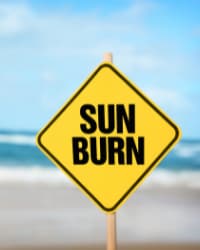Sun Safety
By: Dr. James Fanning, Fisher-Titus Cancer Care Center
With the summer well underway, the time to enjoy the outdoors is upon us. Whether you’re planning to have a picnic, or just enjoy your own backyard, you will likely be spending a lot of time under the summer sun. While soaking up the sun is a favorite summer pastime for many, that “healthy glow” can quickly become skin damage.
or just enjoy your own backyard, you will likely be spending a lot of time under the summer sun. While soaking up the sun is a favorite summer pastime for many, that “healthy glow” can quickly become skin damage.
What is Sun Damage?
The ultraviolet radiation found in sunlight is absorbed by the skin and can damage the genetic material in skin cells whether you get a sunburn or not. Over time, this damage accumulates and increases your risk of developing skin cancer.
While sunlight exposure can cause damage at any age, exposure earlier in life is particularly dangerous. According to a study published by the American Association for Cancer Research, there is a direct link between sunburns earlier in life and higher risk of melanoma skin cancer. The women in the study who experienced a minimum of five sunburns between the ages of 15 and 20 years old were 80 percent more likely to later develop melanoma skin cancer than others.
Early exposure means cells have more time to become damaged and ultimately result in skin cancer. That is why it is important to not only take precautionary steps to protect yourself, but your children as well. Skin damage can start at a young age, but so can safe sun exposure habits.
Preventing Sun Damage
On warm summer days it is natural to want to get outside and enjoy the sun. So, taking necessary steps to protect your skin from sun exposure should also be second nature.
Try to avoid direct sun exposure, especially between 10a.m. and 4 p.m. when UV rays are the strongest. Plan any outdoor activities either early in the morning or late in the afternoon. Seek or create shade using umbrellas, shelters, or even a tree. Remember, there is no such thing as a “safe tan” so avoid tanning beds and sunlamps, which can also result in serious long-term skin damage and contribute to skin cancer.
While it is best to stay out of the sun altogether, protecting yourself from the sun does not have to mean becoming a hermit during the summer months. By keeping these tips in mind, you can reduce the damage done to your skin without having to miss out on any of the outdoor fun and holiday festivities.
This slip-slop-slap method of sun protection is based off an Australian sun safety campaign and is an easy way to remember how to protect yourself and your skin.
- Slip: Slip on a shirt and other clothing to protect as much skin as possible.
- Slop: Slop on sunscreen wherever your skin may be exposed. Make sure to use a broad-spectrum sunscreen with a minimum of 30 SPF. Reapply at least every two hours and always after swimming, sweating, or towel drying.
- Slap: Slap on a hat and sunglasses that block at least 99 percent of UV light.
In the United States, skin cancer is currently the most commonly diagnosed cancer. Pay attention to any new growths, sores, spots, and patches on your body that aren’t healing within a few weeks and consider scheduling a visit to your doctor. And remember, before you head outside, slip-slop-slap!
About Dr. Fanning
Dr. James Fanning is an Oncologist with Fisher-Titus Cancer Care Center. For over 20 years, the Fisher-Titus Cancer Care Center has delivered comprehensive care for people with all types of cancer. Fisher-Titus’s cancer program has held Commission on Cancer accreditation since 1989. For more information, visit fishertitus.org/cancer.